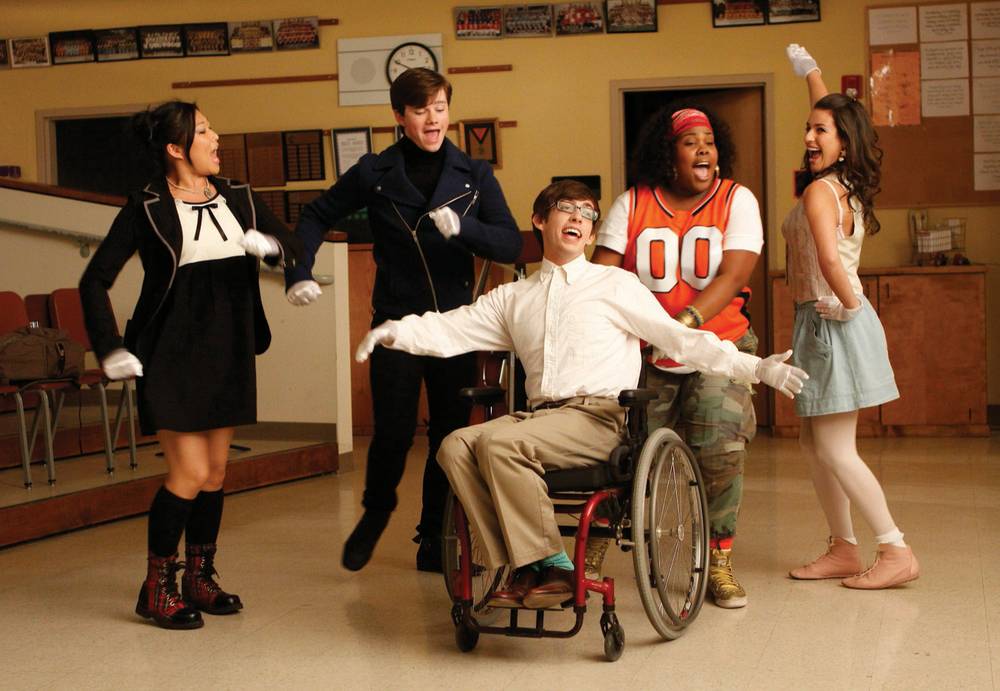Glee, the extremely weird new show from Nip/Tuck creator Ryan Murphy, opens like it’s going to be High School Musical 4: a squad of high-school cheerleaders, kinetic moves, a big modern-yet-traditional dance beat, some catchy melodies. Then the routine ends, one of the cheerleaders falls on her ass, and Jane Lynch shows up as the coach who berates the squad for not being perfect. “You think this is hard?” she says into a megaphone. “Try being waterboarded.”
Glee, which premieres May 19 at 9 p.m. on Fox, right after American Idol, is an ambitious, schizophrenic, occasionally brilliant mess, and is probably doomed to failure based solely on its audacity. Fox, however, seems to think it’s the next big thing; not only is the premiere airing after the penultimate episode of TV’s most popular show, but it’s also just a big tease for the actual series debut in the fall. Glee’s pilot will air this coming week, and then the next installment won’t show up until August or September (when, one assumes, it will be accompanied by a repeat of the first episode). This strategy anticipates months of hype for a show that in all likelihood would be a better fit on HBO or FX (home of Nip/Tuck).
Still, give the folks at Fox credit for going all out: Glee’s pilot, directed and co-written by Murphy, looks like a well-budgeted feature film, and its musical numbers (yes, this is a prime-time TV musical) don’t skimp on the grandeur or the presumably high licensing fees for popular songs. Although it has essentially the same plot as High School Musical—a macho jock wants to let the music in his soul ring out, but fears the reprisal of his peers—Glee is far from a squeaky-clean tale about tolerance and openness. Instead, it’s a strange combination of campy, acid-tongued satire, traditional song-and-dance showcase and earnest teen drama, often all within the same scene.
It’s hard to tell whether Murphy means for the audience to take seriously his characters’ efforts to better themselves; the moments of lesson-learning are so achingly heartfelt that they seem like sarcasm when butting right up against deadpan takedowns of suburban ennui. And then, right after a nasty scene with Jessalyn Gilsig as the over-the-top harpy married to Matthew Morrison’s pure-hearted glee-club advisor, there’s a giant musical number set to Journey’s “Don’t Stop Believin’,” complete with intricate choreography. What?
Black comedy careens headlong into surges of cheesy emotion with no concern for consistency, and yet against all odds the whole thing kind of works. It certainly pulls off the musical format better than any other network series in memory (not that the likes of Viva Laughlin and Cop Rock are tough competition). The focus on the high-school glee club gives the characters reasonable excuses to regularly break into song (although the numbers are still highly stylized), and the subversive take on the teen-melodrama format recalls Murphy’s pre-Nip/Tuck show Popular, which started as a standard-issue WB show before developing a strong sense of camp absurdity. The stars are mostly charming, and the ones called upon to sing actually have strong voices, something that’s often lacking in recent Hollywood musicals.
Murphy’s bizarre ambition makes Glee unlike any other show on TV, but whether Fox knows what to do with a show that’s unlike any other on TV is questionable. So is the issue of how Murphy & Co. will manage to maintain this high level of production values (movie-like shooting style, a soundtrack brimming with well-known songs) over the course of a full season. Even if it crashes and burns (and odds are better than even that it will), Glee will be worth continuing to watch—you’ll just have to wait a few months to do so.


Previous Discussion: